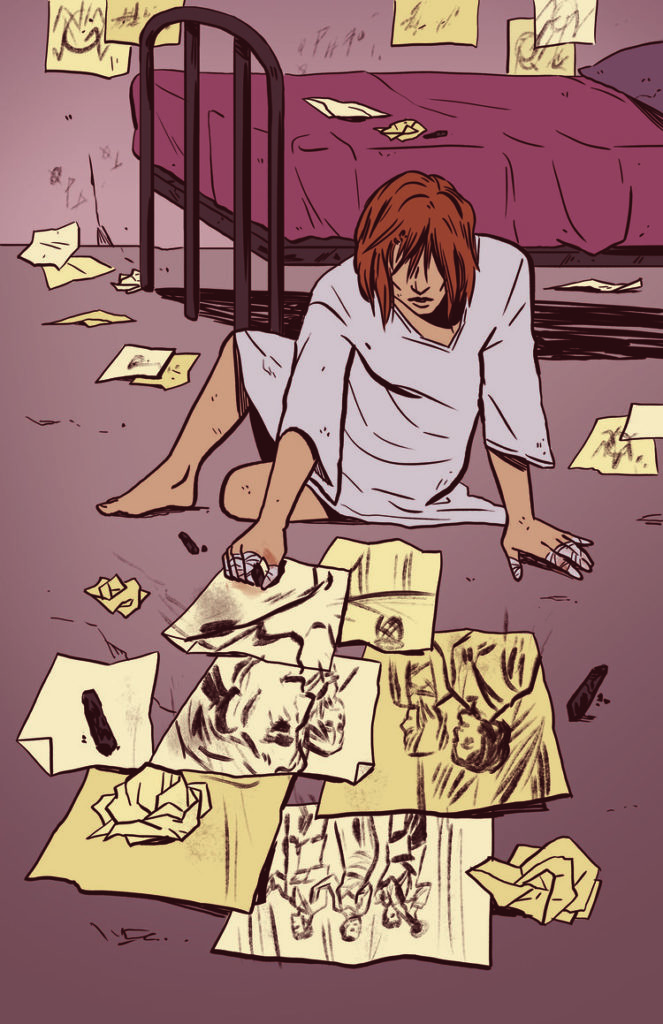ITHAQA #1-3 is the first part of a self-published series by writer Michael Watson, artist & co-creator Theresa Chiechi, and letterer Lucas Gattoni.
About the series:
In ITHAQA, filmmaker and conman Mookie Smitts discovers the horrible Eldritch Truth of the cosmos, as a moving picture he is struggling to produce in the 1920s accidentally uncovers a plot to destroy the Spacetime Continuum.

Writing
Watson’s non-linear approach to this story makes this comic feel truly mysterious and engaging. Each issue operates in the same manner. It opens and ends with a scene featuring one of the main characters talking to a detective after the event called “The End of Time” has already happened. The reader doesn’t know what this incident entailed or what its name means. But, it’s clear to us this incident has changed the main characters’ lives dramatically. The End of Time scarred them all forever- some in subtler ways than others. By setting up the mystery so well, Watson keeps the reader guessing. Conjuring up the theories as to what it all means becomes part of the fun.
This non-linear approach does make for anticlimactic endings. But, between the beginning and the end, we experience and learn many new things. So much so that the ending serves as some kind of breather from the panic and chaos taking place throughout each chapter.
Art
Chiechi’s artwork is gorgeous. The facial expressions are well-drawn, the colors manage to establish the mood well for the reader, and the artwork’s style has a Disney touch to it, which oddly works. But, her mastery of costume design is what’s truly admirable here. Anything the reader wants to know about a character’s personality, they can find out by looking at how this character dresses. Hazel, the group’s optimistic, gullible girl, almost always sports a red bucket hat, which seamlessly elevates her naiveness and makes her look like a child. The rebellious Margaret always dons a long, red skirt; The red so bold and courageous, it beautifully captures her toughness and stubbornness during these unforgiving times.
Chiechi’s artwork definitely succeeds in impressively embodying the spirits of the 1920s. But, where it doesn’t quite work are ITHAQA’s terrifying, supernatural sequences. When the time comes for Chiechi to outright scare the reader, it feels like Chiechi pulls her punches and doesn’t deliver on the real horrific images we’ve all been waiting to see.

Lettering
Gattoni’s lettering gives the creative team a crude nudge in the right direction in terms of tone and style, and then some. Except for a few odd balloon placements, Gattoni knows exactly how to further immerse the reader in the story’s world. It’s clear Gattoni had a lot of fun with designing the balloons, captions, and sound effects. Especially the balloons when a character casts spells in an unknown language; They look so otherworldly and chaotic; the reader almost feels like the spelling is being cast on them. Noteworthy work here from Gattoni.
Conclusion
It’s easy to forget ITHAQA was made during this last decade. Everything about this comic just sucks the reader into its world without ever breaking the ultimate spell, the suspension of disbelief. The mystery grows bigger and stronger with each chapter to a point where the reader can’t help but try to figure out for themselves what’s about to happen next. Strongly recommended for fans of Lovecraftian horror and stories about the days of the past.

